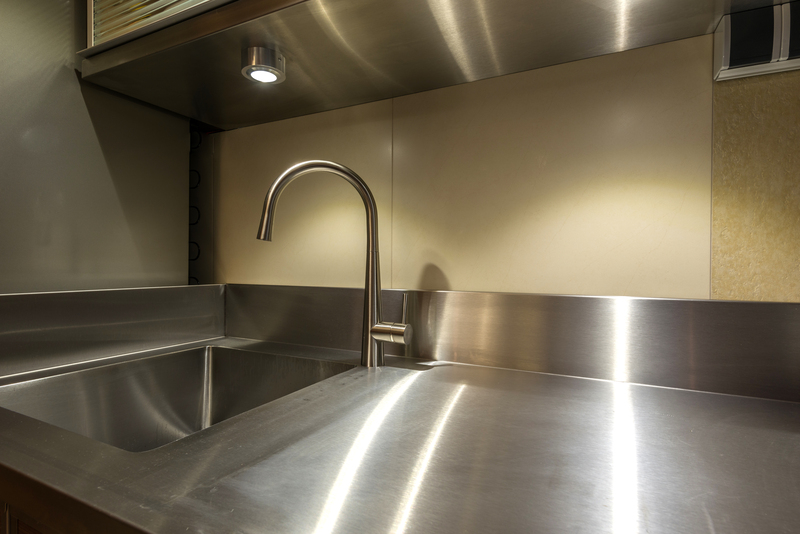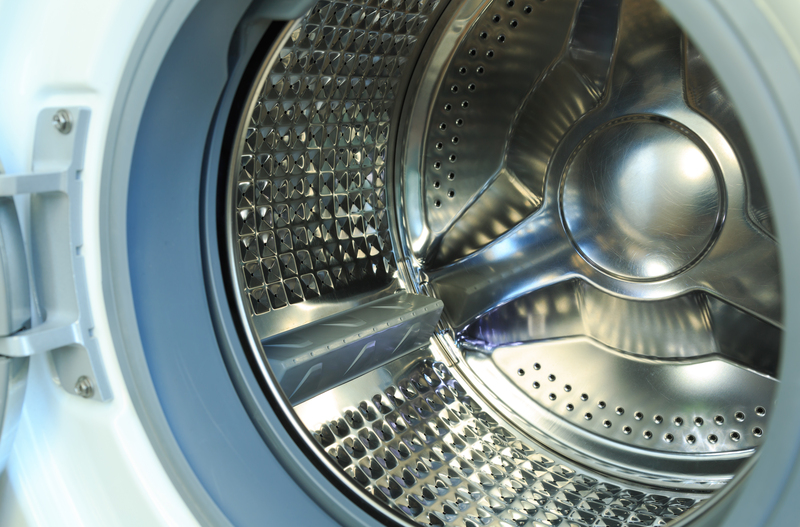Step-by-Step Guide to a Mold-Free Bathroom Environment
Posted on 18/08/2025
Step-by-Step Guide to a Mold-Free Bathroom Environment
Is your bathroom prone to unsightly black spots, musty odors, or persistent dampness? These are common signs of mold infestation. Mold not only compromises the aesthetic appeal of your bathroom but can also pose significant health risks, including allergies and respiratory issues. This comprehensive guide explores proven strategies for creating and maintaining a mold-free bathroom environment, helping you safeguard your family's health and keep your bathroom sparkling clean.
Why Bathroom Mold Is a Problem
Mold thrives in moist, humid spaces, making bathrooms a top breeding ground. Beyond being unsightly, mold can:
- Trigger allergies and asthma attacks
- Cause respiratory problems and irritation
- Damage walls, ceilings, grout, and fixtures
- Reduce your home's value if left untreated
Recognizing the risks is the first step towards a mold-free bathroom. Next, let's delve into how you can achieve this goal.

Key Factors That Promote Mold in Bathrooms
Understanding what causes bathroom mold empowers you to effectively prevent and address it. The main factors are:
- Humidity from showers and baths
- Poor ventilation
- Leaky plumbing or fixtures
- Standing water or damp surfaces
- Organic matter (soap scum, skin cells, etc.) as food for mold spores
Your journey to a bathroom mold solution starts by tackling these variables head-on.
Step 1: Identify Mold Hotspots in Your Bathroom
Inspect the following places as they're most susceptible to mold:
- Ceilings, especially above showers
- Grout lines and tiles
- Behind toilets and under sinks
- Shower curtains and bath mats
- Ventilation fans and window sills
Spot any discolored patches, fuzzy growth, or a dank odor? These are clear indicators of a mold problem requiring immediate attention.
Step 2: Improve Bathroom Ventilation
Ventilation is crucial for a mold-free bathroom environment. Follow these guidelines to boost airflow and limit moisture:
-
Install a quality exhaust fan:
- Ensure it's vented outside, not just into the attic.
- Choose a fan rated for your bathroom's size (measured in CFM--cubic feet per minute).
- Run the fan during and at least 30 minutes after each shower.
-
Open windows:
- When weather permits, crack open windows to let steam escape.
-
Leave bathroom doors open:
- This helps moisture dissipate after bathing.
-
Consider a dehumidifier:
- Especially effective in bathrooms without windows or with persistent humidity issues.
Proper ventilation is the foundation of any mold prevention bathroom plan.
Step 3: Control Humidity & Moisture
High humidity equals high mold risk. To maintain a mold-free bathroom environment, aim to keep humidity below 50%:
- Use a humidity gauge (hygrometer) to monitor levels regularly.
- Wipe down wet surfaces (showers, counters, sills) after use.
- Hang towels and bath mats to dry outside of the bathroom when possible.
- Quickly mop up any standing water on floors or in bathtubs.
- Check and repair leaky faucets, pipes, or toilet seals promptly.
Helpful Tip:
Squeegees are your friend! Use a squeegee after each shower to remove water from tiles and glass, reducing surface moisture and speeding up drying time.
Step 4: Clean Regularly With Mold-Fighting Solutions
Routine cleaning is key for a mold-free bathroom. For best results:
- Scrub grout lines, tiles, and sinks weekly using mold-killing cleaners.
- Wash shower curtains and plastic liners in hot water with laundry detergent and baking soda every two weeks.
- Disinfect bath mats and let them dry completely before putting them back.
- Use a mild bleach solution (1:10 with water), hydrogen peroxide, or specialty bathroom mold products for stubborn spots.
- Don't forget hidden spots--check under shampoo bottles, razor holders, and in soap dishes.
DIY Natural Cleaning Solutions:
- Mix white vinegar and water (1:1 ratio) in a spray bottle for daily wipe-downs.
- For persistent mold, spray pure vinegar on affected areas, let sit for an hour, then scrub and rinse.
- Baking soda paste (with a little water) is great for gentle scrubbing of grout and tiles.
Caution: Never mix bleach and ammonia products; the resulting fumes are toxic.
Step 5: Choose Mold-Resistant Materials and Paints
If you're remodeling or updating your bathroom, opt for mold-resistant materials to drastically lower future risks:
- Mold-resistant drywall (green board or cement board) for walls and ceilings.
- Mildew-resistant paints for walls and ceilings--these often contain antimicrobial agents.
- Seal grout and tile regularly (every 6-12 months) with a waterproof sealer to prevent moisture absorption.
- Choose glass doors over shower curtains for easier cleaning and fewer mold-trapping crevices.
When building or renovating, plan for optimal airflow, adequate lighting, and easy-to-clean surfaces.
Step 6: Maintain Plumbing Integrity
Leaky pipes and fixtures are a main source of chronic bathroom dampness. Be vigilant with:
- Checking under sinks, around the base of toilets, and behind showers for signs of drips or water stains.
- Replacing worn-out caulking or grout promptly to stop water from seeping behind tiles.
- Ensuring all plumbing is in good condition--call a plumber for any persistent leaks.
Proactive Maintenance Checklist:
- Inspect caulking and grout at least twice a year.
- Listen for running water when fixtures are off (possible hidden leaks).
- Look for rust, mold, or mineral buildup on pipes and connections.
Step 7: Declutter and Organize for Easy Cleaning
Excess items trap moisture and impede airflow, making it easier for mold to take hold. To keep your bathroom mold-free long-term:
- Store toiletries on shelves or in ventilated containers--not directly on tub edges or sills.
- Limit decor and porous objects (rugs, wooden items) prone to moisture absorption.
- Keep cabinets and storage areas organized for easy spot checks and quick cleanups.
Step 8: Address Mold Immediately When Found
Even the best prevention can't stop every single mold spore. Act quickly when you notice mold:
-
Small areas (< 10 square feet):
- Scrub thoroughly with an appropriate cleaning solution.
- Dry the area completely with a fan or dehumidifier.
-
More widespread or recurrent mold issues:
- Consult a mold remediation specialist--especially for mold behind walls, under flooring, or in HVAC systems.
Step 9: Foster Good Bathroom Habits Among Household Members
Cultivating habits that minimize moisture and maximize ventilation is crucial for ongoing success. Remind everyone to:
- Keep the fan or window on during and after showers.
- Hang towels/tub mats to dry elsewhere.
- Wipe down surfaces and squeegee shower walls after each use.
- Clean up water spills immediately.
- Avoid leaving wet items in the bathroom for extended periods.
Step 10: Schedule Deep Cleans and Inspections Seasonally
Even with daily upkeep, set aside time every few months for a comprehensive bathroom cleaning and inspection. During these sessions:
- Move furniture and storage bins to check hidden areas for mold and leaks.
- Scrub air vents, light fixtures, and other often-overlooked surfaces.
- Check for subtle signs of moisture damage or decay.
- Replace old caulk, grout, and any materials showing mold damage promptly.
Summary Checklist: The Ultimate Mold-Free Bathroom Environment
- Inspect and eliminate moisture sources (leaks, drips, pooled water)
- Ensure proper and ongoing ventilation (fans, dehumidifiers, windows)
- Clean all surfaces frequently with mold-targeted products
- Declutter and prevent moisture-trapping items
- Address any mold promptly--no delay!
- Monitor humidity and adjust bathroom habits for everyone in the household

Frequently Asked Questions About Bathroom Mold Prevention
How can I tell if my bathroom mold is dangerous?
Most household bathroom mold is not toxic, but all should be treated seriously. If you find black mold (often Stachybotrys chartarum), or if mold covers a large area or recurs persistently, consult a mold removal professional.
Are natural remedies effective in preventing bathroom mold?
Yes--white vinegar, baking soda, and hydrogen peroxide are effective for cleaning and maintenance. But for stubborn or widespread mold, specialty commercial products or professional remediation may be required.
How often should I clean my bathroom to avoid mold?
Wipe down exposed surfaces daily, deep clean weekly, and schedule a thorough inspection and cleaning every three months for the best mold prevention results.
Final Thoughts: Achieving a Mold-Free Bathroom Environment
A mold-free bathroom environment enhances both your home's health and beauty. With consistent vigilance, smart cleaning habits, and the right prevention tools, you can banish bathroom mold for good. Remember--prevention is far easier than remediation! Apply these steps, involve the whole household, and you'll enjoy a pristine, mold-free bathroom year-round.
Ready to take the next step? Put this guide into action today and rest easy knowing you've protected your bathroom and your family's well-being from the perils of mold.



